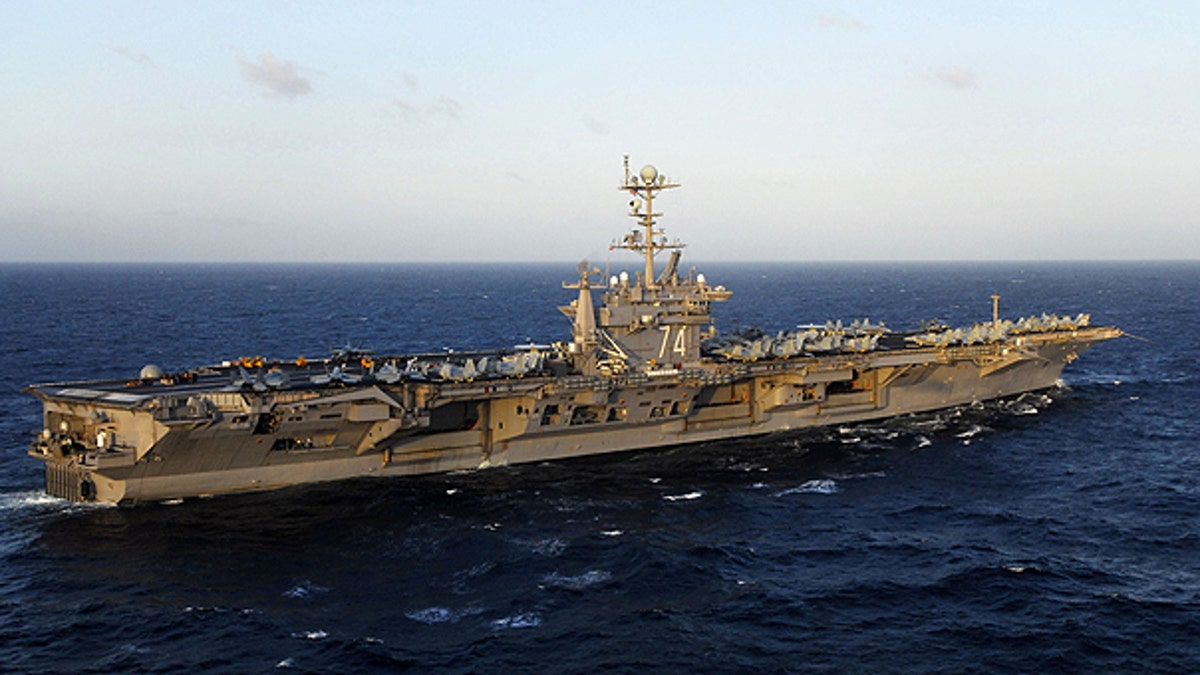
In this image provided by the U.S. Navy the aircraft carrier USS John C. Stennis is shown at sea in the Pacific Ocean on Nov. 14, 2009. (AP)
SAN DIEGO – Military officials on Thursday said they were trying to determine what caused the engine of a fighter jet to fail and catch fire as it prepared to take off from an aircraft carrier in the Pacific Ocean.
The mishap left eight sailors, one Marine and two civilians injured aboard the USS John C. Stennis, Naval Air Forces Lt. Aaron V. Kakiel said.
The Navy initially reported 10 sailors were injured.
None of the injuries sustained during the training exercise Wednesday off the California coast was life-threatening.
Two of the four sailors airlifted to a Navy hospital in San Diego were released Thursday, and another could be out by the end of the week, Kakiel said. The fourth sailor suffered a fractured femur and bruised hip and could be hospitalized longer.
The seven other people were treated on board the carrier for minor injuries such as light burns, twisted ankles and skinned knees sustained while they fought the fire, said Capt. Ronald Reis, who spoke to reporters in a teleconference call from the carrier.
The Marine pilot, in his early 20s, escaped unharmed after crew members made their way through the flames and billowing smoke to help him out of the cockpit, Reis said.
The jet was just 10 seconds from being launched when its right engine exploded, hurling flames and parts through the air.
One part struck a sailor in a nearby aircraft in the chest. Another sailor, also in an accompanying plane, suffered a broken femur, but Reis said he had not had a chance to speak with him to find out how the fracture happened.
When Reis saw the leaping flames, he told his crew to fight the fire.
He said his concern was for the safety of those on the flight deck and that the fire would spread to the other 80 aircraft on the ship and even to the carrier.
"Things could have turned for the worse," he said. "I was taken back at how quickly and how well they ended up ultimately putting that fire out."
The F/A-18C Hornet sustained at least $1 million in damage during the brief fire. The ship had no significant damage.
Investigators were reviewing the jet's maintenance to ensure everything was done properly and looking into whether an engine part came loose and caused the explosion. The probe could take three to six months, Reis said.
Reis doesn't believe crew members missed anything when they checked the jet beforehand, including for objects that could be pulled into the engine. He said all indications are that something internally went awry. He said the engine has been extremely reliable in the past.
The pilot appeared to have done everything properly, Reis said. He expected the military to allow him to return to be certified.
The Stennis is based in Bremerton, Wash., and was conducting qualification flights for pilots and crews about 100 miles off the coast of San Diego. Flight operations resumed without problems Thursday, Reis said.
The aircraft was assigned to Marine Fighter Attack Training Squadron 101 based at Marine Corps Air Station Miramar.
The F/A-18C Hornet, which was used in Operation Desert Storm, is a fighter-attack aircraft that can carry air-to-air missiles and infrared imaging air-to-ground missiles.
Click here to read more on this story from Fox5SanDiego.com.

